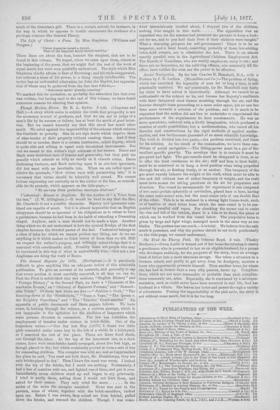Aerial Navigation. By the late Charles B. Mansfield, M.A., with
a Preface by J. M. Ludlow. (Macmillan and Co.)—The problem of flying, which has exercised the ingenuity of man for so long a time, is still practically unsolved. Wo say praetically, for Mr. Mansfield may fairly lay claim to have solved it theoretically. Although we cannot be as enthusiastic on the subject as ho, and foresee her Majesty's mailboats with their lacquered steel frames scudding through the air, and the heavier draught boats proceeding at a more sober apace, yet no one has done more towards a solution of the problem, and it is much to be regretted that the author did not live to undertake or superintend the performance of the experiments he here recommends. He was no mere speculator, endowed with a lively imagination, which produced a number of crude possibilities; but a mathematician, who tested all his theories and constructions by the rigid methods of applied mathe- mattes, and was furthermore possessed of no mean scientific knowledge. The work is divided into two parts,---the problem examined, and hints for its solution. As the result of the examination, we have these con- ditions of aerial navigation :—The lifting-power must be a gas of the smallest specific gravity. The envelope that is to contain it must be. gas-proof and light. The gas-vessels must he elongated in form, so as to offer the least resistance to the air ; stiff and firm in their build ; must be so contrived as to keep a level position when being propelled through the air, or floating freely, or at anchor. The buoyancy of the. gas must exactly balance the weight of the craft, which must be able to rise and fall without loss of either buoyancy or weight, and the craft must have means for taking purchase on the air for propulsion and direction. The vessel he recommends for experiment is one composed of two semi-prolate spheroids of revolution, placed base to base, having the same semi-minor axis, but the semi-major axis of one double that of the other. This is to be enclosed in a strong light frame-work, such as of bamboo or steel tubes from which the man-vessel is to be sus- pended by parallel stiff ropes. For checking the career and to assist the rise and fall of the vehicle, there is a kite to be fixed, the plane of which can be worked from the vessel below. The propulsive force is given by large and light wings, managed much in the same way as =- blades. The preface has one merit,—it is brief. We believe it is the only. merit it possesses, and why the preface should be set forth particularly on the title-page, we cannot understand.


































 Previous page
Previous page